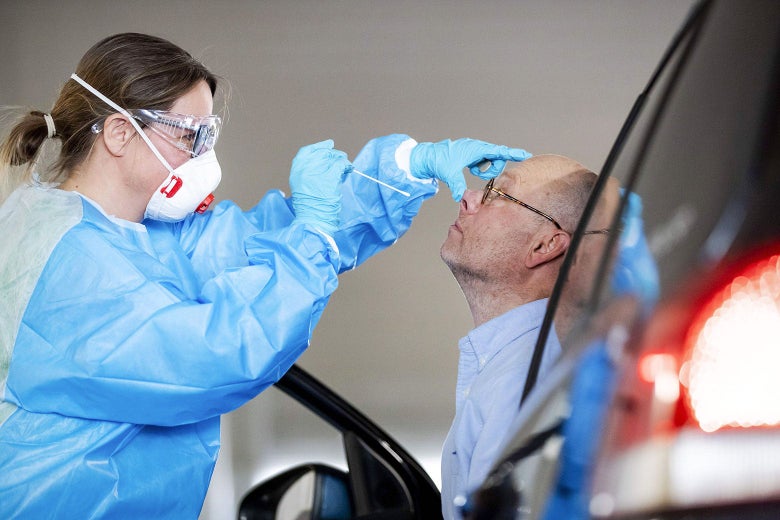
Drive-thru testing in Rotterdam, Netherlands, on Monday.
Robin van Lonkhuijsen/ANP/AFP via Getty Images
Slate is making its coronavirus coverage free for all readers. Subscribe to support our journalism. Start your free trial.
The United States has bungled basically every aspect of its coronavirus response, but one of the most concerning setbacks has been its limited testing. Though the country has tested more than 1.2 million people for the coronavirus as of April 1, the tests came too late for a South Korea–style clampdown on the disease, and they’re still not widespread enough. But even as more and more Americans are finally being checked, a new concern has emerged: The tests seem to have a problematically high false-negative rate, meaning that many people who get tested are receiving a negative test result despite having the virus.
No one is certain exactly how many tests are spitting back false negatives. One preprint paper relying on biological specimens from 213 patients in China suggested a false-negative rate as high as 30 percent. In a New York Times op-ed, Harlan M. Krumholz, director of the Yale New Haven Hospital Center for Outcomes Research and Evaluation, wrote, “Some of my colleagues, experts in laboratory medicine, express concerns the false-negative rate in this country could be even higher.” Patients have received suspicious results suggesting they don’t have the coronavirus infection despite having symptoms that are completely consistent with what we know about the virus, including high temperatures and a telltale cough. Perhaps the most notable example of a false negative is Li Wenliang, an ophthalmologist in Wuhan, China, who brought COVID-19 to international attention. Li died of the virus, but only after he repeatedly tested negative for the disease.
The real problem likely lies not in the lab but in the samples doctors are taking from their patients to send in for testing.
No test is perfect. The latest rapid influenza test, for example, has a false-negative rate around 20 percent. In the case of COVID-19 testing, some misdiagnoses could come from lab issues. There’s always a degree of error involved in any testing, through some combination of flawed human action and flawed baseline testing. But these days, machines are more capable than ever of calling out and correcting these issues. And the primary test for the novel coronavirus—the RT-PCR, or reverse transcription polymerase chain reaction—is “actually really good,” said Jeff Pothof, chief quality officer at UW Health. “So good that if we can capture a single strand of RNA, we can get a result.” The real problem likely lies not in the lab but in the samples doctors are taking from their patients to send in for testing.
Every virus has its preferred place in its host’s body. But the coronavirus “is a little sneakier than viruses we’ve seen in the past,” said Nam Tran, an associate clinical professor at the University of California, Davis. COVID-19 is primarily a disease of the lungs, but it also hangs out in the nasopharynx, a hard-to-reach cavity halfway between your nose and your throat. The main strategy for testing has been to stick a long swab so deep into people’s noses it actually lands in the nasopharynx—a process one TikTok user described as akin to “being stabbed in the brain.”
Both Pothof and Tran think that one of the primary reasons RT-PCR tests are getting false negatives is because doctors and nurses aren’t getting all the way into the nasopharynx. Patients may back away in discomfort. And people administering the test may be rushing from patient to patient, so the quality of each individual swab may suffer. When a swab with no COVID-19 on it arrives in the lab, it doesn’t matter how sensitive the RT-PCR is. “If the sample is junk, just to be blunt, you’re not going to find anything,” Tran said.
False negatives may also be a matter of timing. “There’s a misconception if a person has COVID, the virus is all over the place,” Tran said. “That’s not true.” It mostly concentrates in the lungs, which is why some doctors have advocated for chest CT scans or lower respiratory tract specimens as means of testing. It doesn’t appear in the blood, though eventually people who survive the disease begin to produce antibodies to the virus that can be detected in a blood sample. And though COVID-19 can be found in the nasopharynx and even the nasal cavity itself, the concentration of the virus varies over time. Right now, the test appears to be most effective in patients who have been showing symptoms (specifically a fever and cough) for three to five days, said Omai Garner, an assistant professor of pathology and laboratory medicine at UCLA. No one knows how well it detects the virus in people who are asymptomatic, or how reliable it is after a patient has begun to recover.
That doesn’t mean the COVID-19 test itself is a failure. But its imperfections do have serious implications for how we manage the pandemic. We need more research to better understand how the coronavirus appears in different parts of the body and at different times throughout the illness. Doctors need better training and information on how to administer the tests, and when. People with serious symptoms who test negative need multiple tests, in order to ensure their diagnosis is certain. And most importantly, patients with symptoms that are consistent with COVID should still behave as though they are infected, no matter what their lab results suggest.
from Slate Magazine https://ift.tt/34g0Qzn
via IFTTT
沒有留言:
張貼留言